|
|
Post Last Edit by aurorae at 10-8-2010 03:00

Michigan 4 Ogos 2010 |
|
|
|
|
|
|
|
|
|
|
|
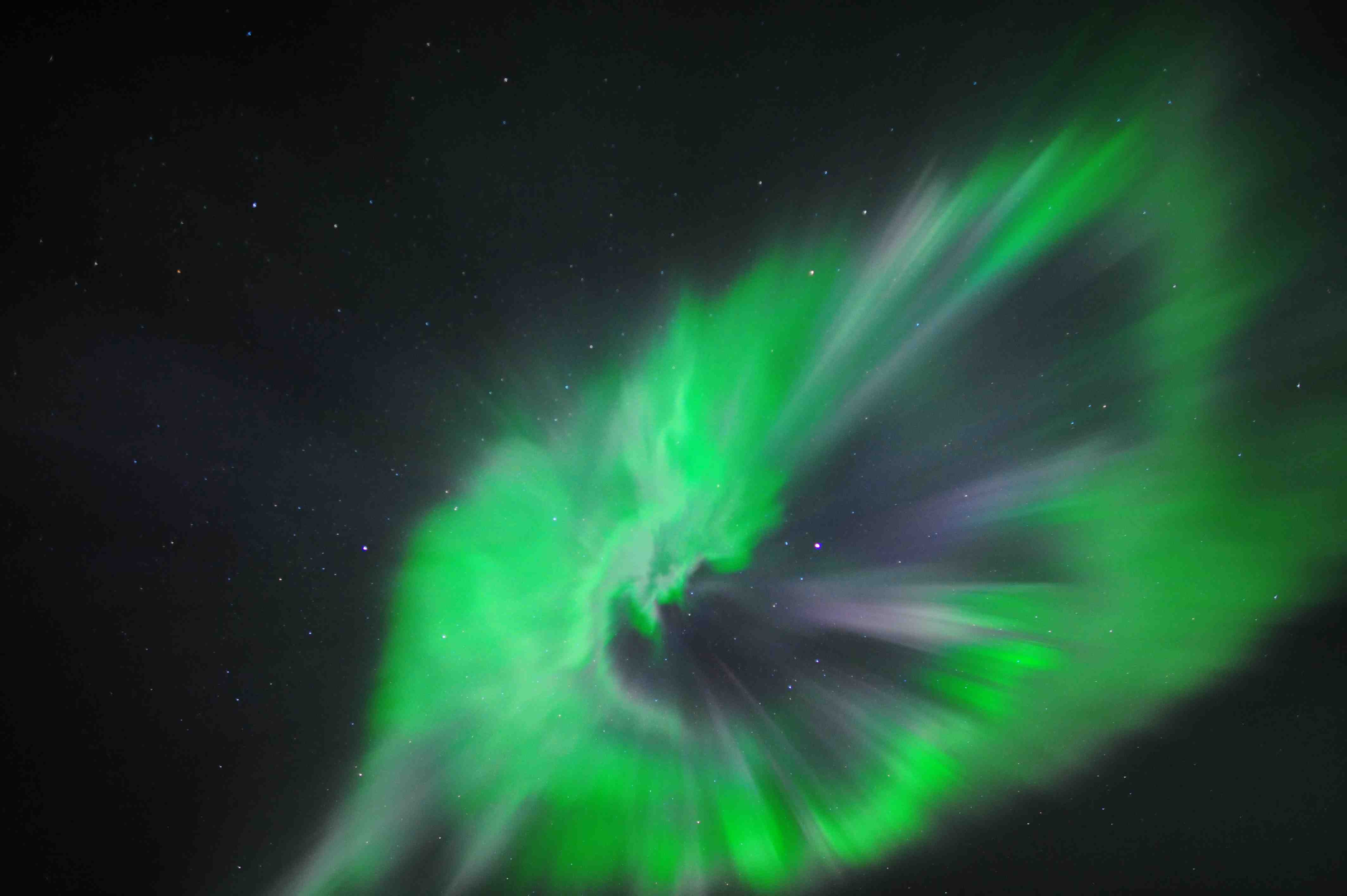
Quebec 4 Ogos 2010 |
|
|
|
|
|
|
|
|
|
|
|
SOLAR BLAST JUST MISSES EARTH: On August 7th (1825 UT), magnetic fields around sunspot 1093 became unstable and erupted, producing a strong M1-class solar flare. Several amateur astronomers caught the active region in mid-flare, while NASA's Solar Dynamics Observatory recorded an extreme ultraviolet movie of the entire event:
The eruption hurled a coronal mass ejection (CME) into space, just missing a direct sun-Earth line. Forecasters expect the cloud to deliver no more than a glancing blow to our planet's magnetic field when it billows by on August 9th or 10th--not a major space weather event.
Future eruptions could turn out differently. Active region 1093 is rotating toward Earth. By the end of this weekend, we'll be in the line of fire if its magnetic fields become unstable again |
|
|
|
|
|
|
|
|
|
|
|
cantiknyer... aimez tggl kat mana eh.. nak dtg rumah boleh?
hehehe
kakbedah Post at 19-5-2009 18:15 
kak bedah,
ku tinggal kat sini bawah kutub utara..canada.
boleh aje, bila nak datang? hehehe |
|
|
|
|
|
|
|
|
|
|
|
aimez....patutnya, instead of the photos,
imej kan juga video with HD bukan senang ada pengalaman ...
me_ai Post at 22-5-2009 22:15 
me_ai, sori byk2 dah lama x jenguk thread nih.
tuler ingatkan nak videokan tp masalahnya sampai skrg aurora x seaktif mcm dulu..
xtaulah naper..kalo ikut carta bwh 80% tu pun susah nak predict skrg..
aritu ada tgk aurora tp kejap jek x clear sgt..apapon nanti ku try lg sbb fall pun dah nak tiba kat sini..
means, musim aurora selain spring.  |
|
|
|
|
|
|
|
|
|
|
|
Reply 88# aimez
ingatkan aktiviti solar ada sikit aktif...
takde juga yer...., dcuba observe n preprae utk thn ni... |
|
|
|
|
|
|
|
|
|
|
|
Reply 89# me_ai
thn ni kat belah Iceland, Norway, Eastern canada & US menang..belah Alberta susah nak cerap...
ada kt bebrp tempat tu pun nak kuar teramatlah jauh..harap2 minggu dpn ni kena try lg hehe |
|
|
|
|
|
|
|
|
|
|
|
Reply 91# aimez
website yg menarik....lama dah tak mendalami benda2 ni, tak jenguk website2, agak ketinggalan...since kerja betmbh2 ni... |
|
|
|
|
|
|
|
|
|
|
|
aku dh lame tau pasal aurora ni....
cuma yg aku tktau ade ke pakej pelancongan dr mesia nk tgk aurora ni? huhu...  |
|
|
|
|
|
|
|
|
|
|
|
masyaAllah cantek~~ pic gabungan ciptaan Ilahi dan kekreatifan manusia~~ pic gabungan ciptaan Ilahi dan kekreatifan manusia~~ |
|
|
|
|
|
|
|
|
|
|
|

Explanation: Curtains of shimmering green light sprawl across this gorgeous night skyscape. In the foreground lies the peaceful Prelude Lake, located about 30 kilometers east of Yellowknife, Northwest Territories, Canada. From high northern latitudes these mesmerizing northern lights, also known as the aurora borealis, are becoming a more familiar sight. As the September 23rd equinox approaches, nights grow longer and a favorable season for aurora begins. Recorded on September 11, this panoramic scene spans about 180 degrees. Brighter stars peering through the auroral glow at the left form the recognizable northern asterism, the Big Dipper. A more compact Pleiades star cluster shines at the far right. |
|
|
|
|
|
|
|
|
|
|
|
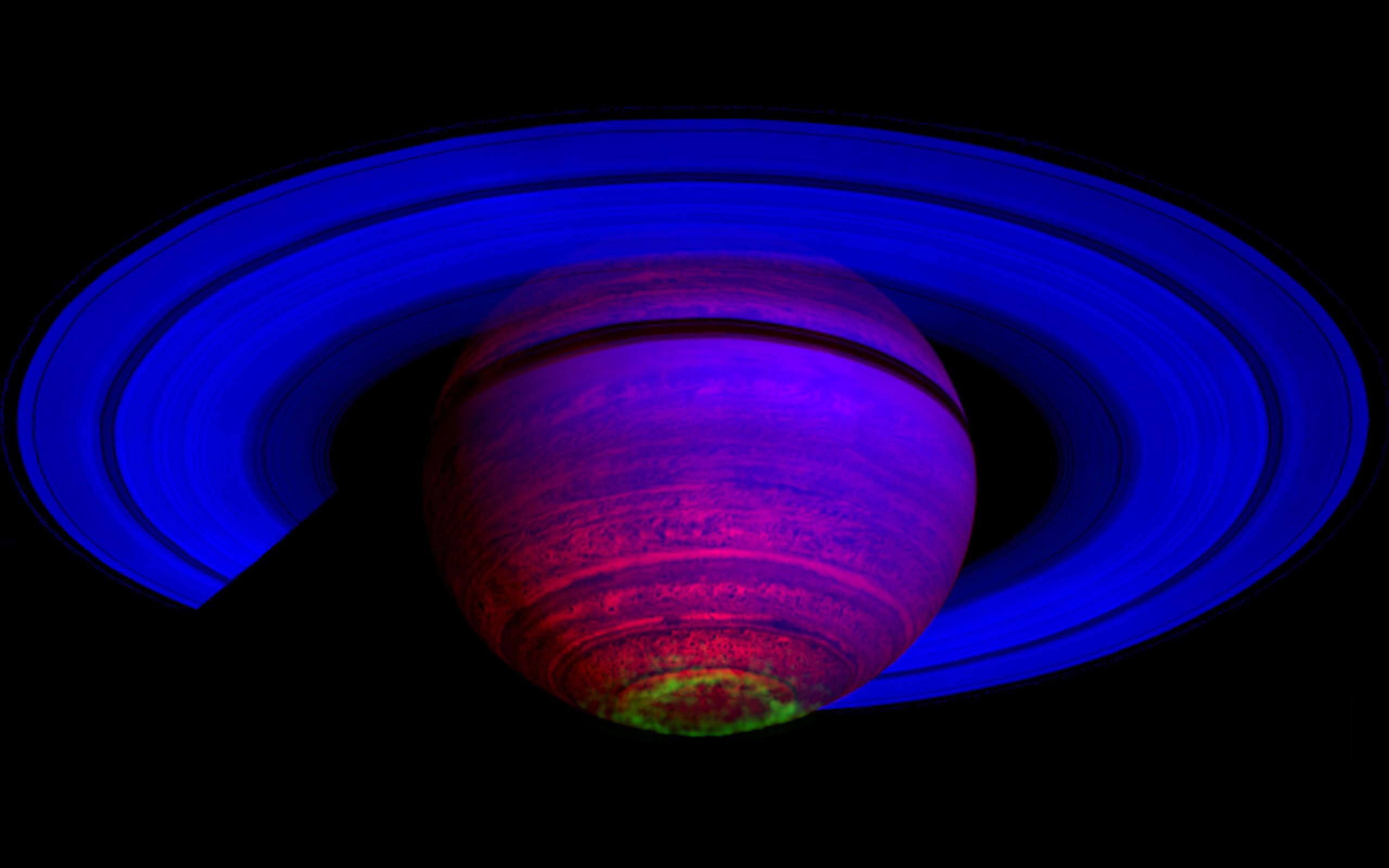
Explanation: What drives auroras on Saturn? To help find out, scientists have sorted through hundreds of infrared images of Saturn taken by the Cassini spacecraft for other purposes, trying to find enough aurora images to correlate changes and make movies. Once made, some movies clearly show that Saturnian auroras can change not only with the angle of the Sun, but also as the planet rotates. Furthermore, some auroral changes appear related to waves in Saturn's magnetosphere likely caused by Saturn's moons. Pictured above, a false-colored image taken in 2007 shows Saturn in three bands of infrared light. The rings reflect relatively blue sunlight, while the planet itself glows in comparatively low energy red. A band of southern aurora in visible in green. Inspection of many more Saturnian images may well lead to an even better understanding of both Saturn's and Earth's auroras. |
|
|
|
|
|
|
|
|
|
|
|
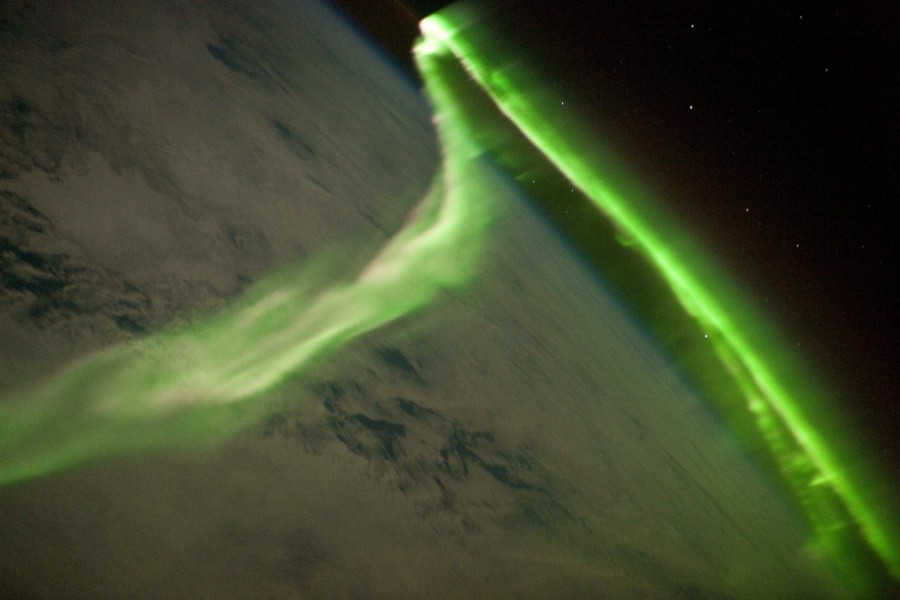
Explanation: On May 29, looking southward from a vantage point about 350 kilometers above the southern Indian Ocean, astronauts onboard the International Space Station watched this enormous, green ribbon shimmering below. Known as aurora australis or southern lights, the shifting, luminous bands are commonly seen at high northern latitudes as well, there known as the aurora borealis or northern lights. North or south their cause is the same though, as energetic charged particles from the magnetosphere pile into the atmosphere near the Earth's poles. To produce the characteristic greenish glow, the energetic particles excite oxygen atoms at altitudes of 100 kilometers or more. Aurora on May 29 were likely triggered by the interaction of the magnetosphere with a coronal mass ejection erupting from the Sun on May 24. |
|
|
|
|
|
|
|
|
|
|
|
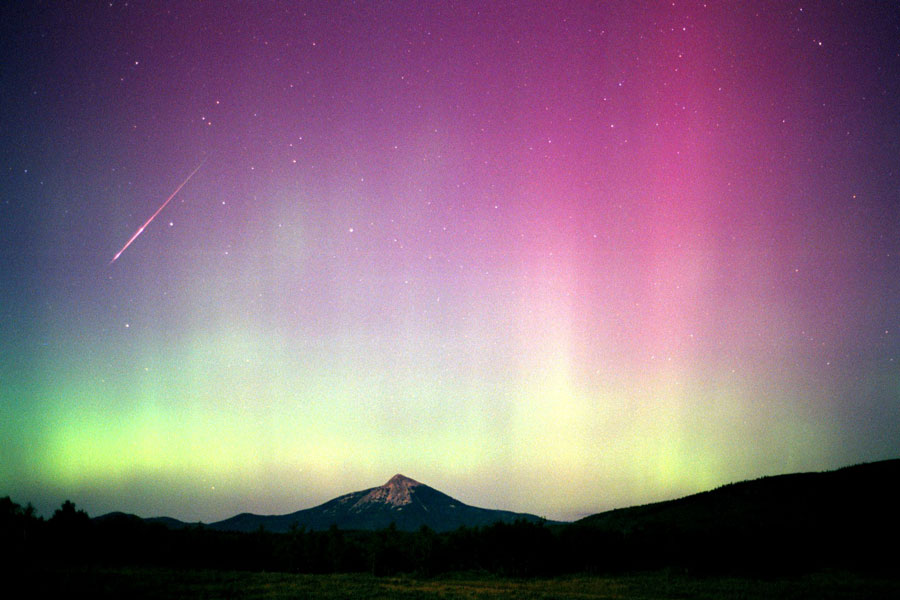
Explanation: Dark skies are favored for viewing meteor showers -- so the best viewing of this year's Perseids will occur in the early morning. While the Perseid meteor shower is scheduled to peak over the next few days, bright light from a gibbous Moon will also flood the early evening and mask the majority of relatively faint meteors. Still, skygazing in the early morning after the Moon sets (after about 2 AM local time) could reveal many faint meteors. Persistant observing at any time after sunset can reward northern hemisphere watchers looking for occasional Perseid fireballs. Astronomer Jimmy Westlake imaged this bright Perseid meteor despite the combination of moonlight and auroral glow over Colorado skies in August of 2000. |
|
|
|
|
|
|
|
|
|
|
|
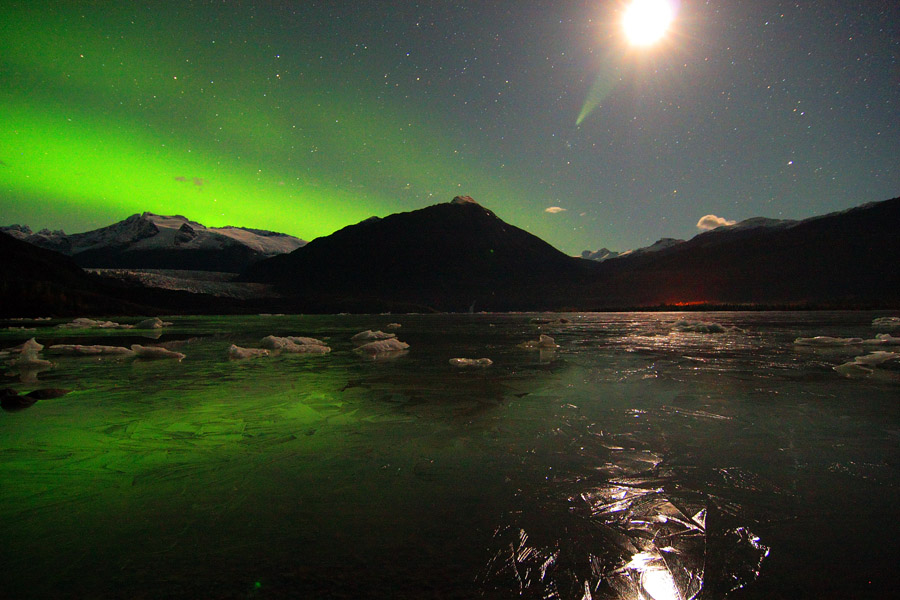
Explanation: Some auroras can only be seen with a camera. They are called sub-visual and are too faint to be seen with the unaided eye. The reason is that the human eye only accumulates light for a fraction of a second at a time, while a camera shutter can be left open indefinitely. When photographing an already picturesque scene above Juneau, Alaska, USA, a camera caught green sub-visual aurora near the horizon. Auroras are sparked by energetic particles from the Sun impacting the magnetic environment around the Earth. Resultant energetic particles such as electrons and protons rain down near the Earth's poles and impact the air. The impacted air molecules temporarily lose electrons, and when oxygen molecules among them reacquire these electrons, they emit green light. Auroras are known to have many shapes and colors. |
|
|
|
|
|
|
|
|
|
|
|
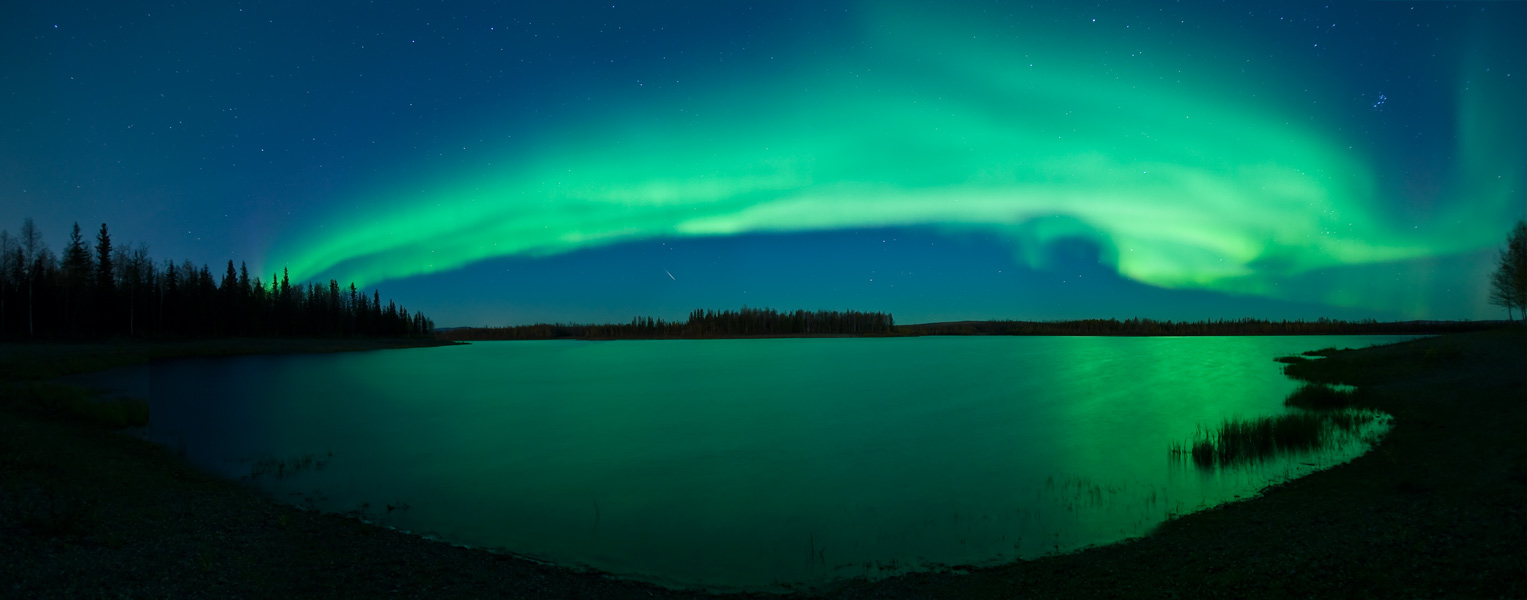
Explanation: Sometimes, after your eyes adapt to the dark, a spectacular sky appears. In this case, a picturesque lake lies in front of you, beautiful green aurora flap high above you, brilliant stars shine far in the distance, and, for a brief moment, a bright meteor streaks by. This digitally fused breathtaking panorama was captured late last month across one of the Chena Lakes in North Pole, Alaska, USA, and includes the Pleiades open cluster of stars on the image right. The shot is unusual not only for the many wonders it has captured simultaneously, but because lakes this far north tend to freeze and become non-reflecting before a sky this dark can be photographed. |
|
|
|
|
|
|
|
|
|
| |
Category: Belia & Informasi
|